Post-Use Care for Your Snow Blower
- April 11, 2024
- 0 comment
Discover the essential steps to maintain your snow blower after each use. Learn how simple post-use care can extend the life of your machine and keep it primed for the next snowfall. Dive into our guide for top snow blower maintenance tips!
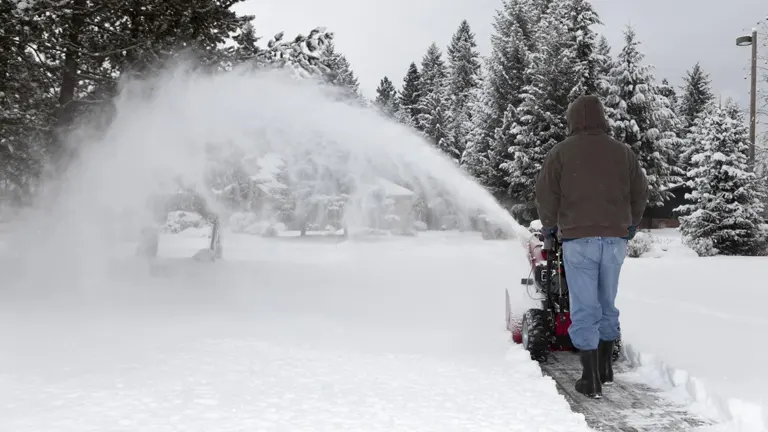
Just tackled the snowy battlefield with your trusty snow blower? Great job! But wait, there’s a little more to do before you kick back and relax. Caring for your snow blower after each snowy showdown is key to keeping it ready for the next frosty round. Let’s make sure it stays in fighting shape, ready to face whatever winter throws your way!
The Importance of Post-Use Maintenance for Your Snowblower
- Snow, ice, and debris can build up in various parts of the snowblower, leading to corrosion or mechanical issues if not cleaned out.
- Regular cleaning and maintenance ensure that your snowblower operates efficiently and effectively, reducing the risk of performance problems during subsequent uses. Proper care after each use can significantly extend the life of your snowblower, preventing premature wear and tear on its components. By maintaining your snowblower well, you can avoid costly repairs and replacements, saving money in the long run.
- A well-maintained snowblower is safer to use. Regular checks and maintenance can help prevent accidents caused by equipment malfunction.
Step-By-Step Guide: Caring for Your Snowblower After Use
1. Cool Down Period
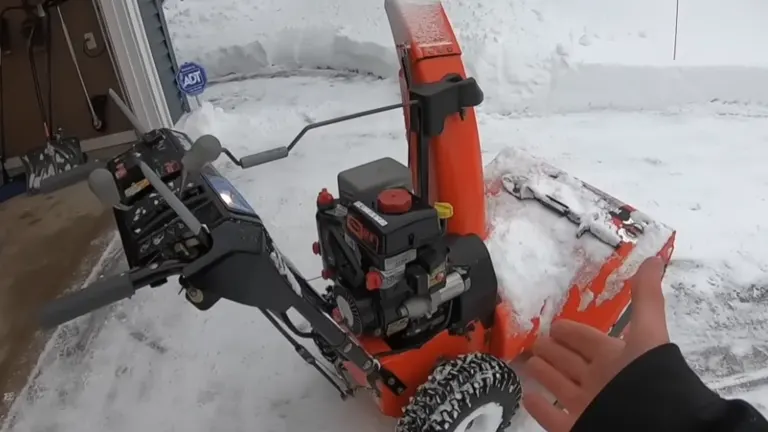
Just like a race car after a heated lap, your snowblower needs a cool-down period. After finishing your snow clearing tasks, reduce the throttle and let it idle for about 30 seconds to a minute before shutting it off. This gradual cool down helps protect the engine from thermal shock.
2. Clean Off the Snow
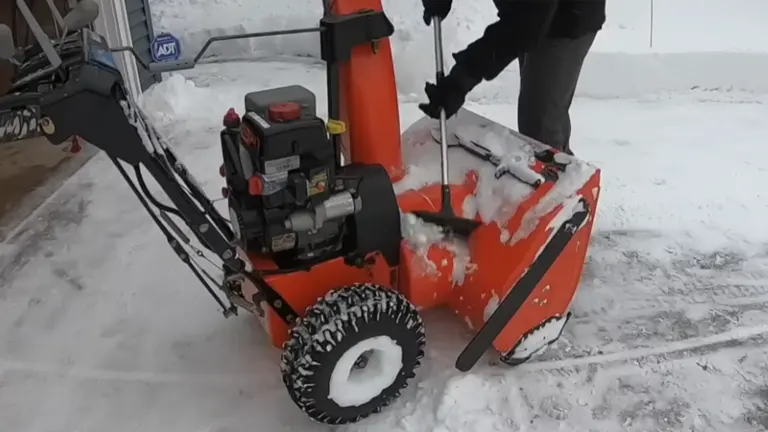
Use a snow brush or a leaf blower to remove snow from the machine. Pay special attention to the top, chute, and exterior. Avoid tampering with the augers directly after use to maintain safety.
3. Indoor Storage

If possible, move your snowblower to a garage or shed. This reduces the risk of mechanical issues and wear from the elements. If you must leave it outside, ensure it’s fully cooled down before covering it up.
4. Drainage and Floor Protection
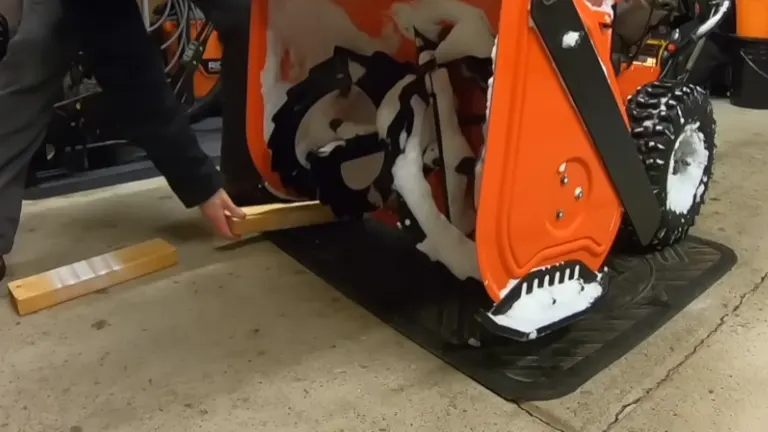
Place your snowblower on a mat inside your storage area to catch melting snow and prevent rust stains on the floor. Elevating the front end using wooden blocks can aid in draining melted snow away from important components.
5. Melting Internal Ice
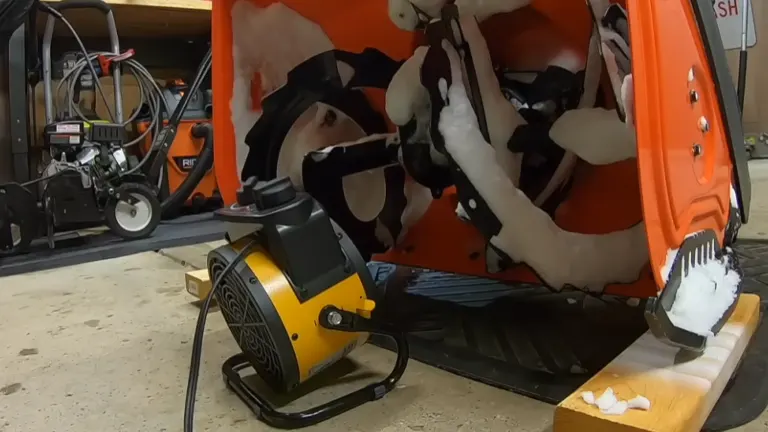
Position a space heater near the auger housing to melt any remaining snow or ice. About 15-30 minutes should suffice. This step is crucial to prevent the impeller from freezing, which could lead to belt damage or breakage.
6. Drying and Protection
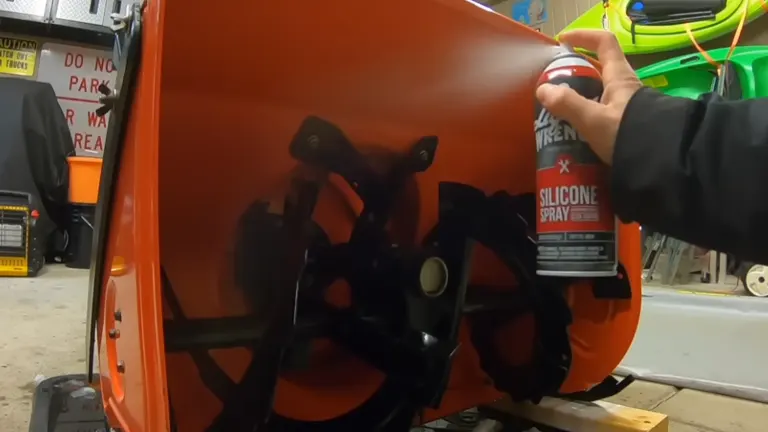
Ensure the snowblower is nearly dry. Apply a protective spray like silicone or WD-40 to the interior and exterior surfaces, especially around the auger and impeller housings and chute. This creates a moisture barrier and a non-stick coating that prevents snow and ice build-up.
Extra Tip: Before tackling the main area of your driveway, clear the end near the street first. This method helps remove the salt and sand mixture from the machine, keeping it cleaner as you finish the rest of the driveway.
By following these steps after each use, your snowblower will not only perform better but will also enjoy a longer operational life, saving you from potential mechanical headaches and ensuring it’s always ready to tackle the winter woes.
Snow Blower Maintenance
Proper maintenance of your snow blower is crucial to its performance and longevity. Before diving into maintenance tasks, ensure all control levers are disengaged, the engine is stopped, and all moving parts have ceased. Remove the key if present, disconnect the spark plug ignition wire on gas models, and unplug the electric models. Always adhere to the manufacturer’s pre-maintenance guidelines and wear appropriate protective gear.
General Maintenance Tips:
- Regularly check for tightness to ensure the machine’s integrity.
- Inspect for wear and damage; adjust or replace as necessary to maintain efficiency and protect surfaces.
- Confirm they engage and disengage correctly, adjusting as required for safe operation.
- Keep tires properly inflated according to the manufacturer’s specifications to enhance maneuverability.
- Apply lubricants as directed by the manufacturer to reduce friction and wear on moving parts.
- Run the blower briefly after use to expel any remaining snow and prevent the auger and impeller from freezing.
For Gas-Powered Models:
- Before each use, check the oil level and top up if needed.
- Replace every 100 hours or annually to ensure smooth starting and running.
- Monitor and change as required to maintain engine performance and longevity.
For Cordless Models:
- Fully charge the batteries prior to use. If stored in a cold area, keep the batteries charged and indoors.
- Follow the manufacturer’s recommendations regarding battery storage and charging during off-season periods.
Caution: Be aware of manufacturer-specific instructions, such as emptying the fuel tank before certain maintenance tasks on gas models to prevent issues and ensure safety.
Snow Blower Repair and Troubleshooting Guide
While it’s often best to have an authorized service provider handle snow blower repairs, there are some troubleshooting steps you can undertake to resolve common issues. Before starting, ensure you follow the pre-maintenance safety steps as outlined in your manual. Here are some typical problems with potential solutions:
Problem: Snow Blower Won’t Start
- Cordless Models: Check the battery’s indicator lights. If it’s overheated, let it cool before attempting to start again.
- Gas Models: Ensure the engine is primed correctly. Inspect the spark plug and clean or replace it if it appears dirty or damaged.
Problem: Engine Stops After Starting (Gas Models)
- Release any vapor lock by slowly loosening the fuel cap to allow gas fumes to escape, then try starting the engine again.
Problem: Rough Running Engine (Gas Models)
- Examine the spark plug and replace or clean it if necessary. Check the fuel cap and its vent for any blockages or damage, and make replacements or adjustments as needed.
Problem: Auger or Paddles Don’t Turn
- Inspect the auger drive belt for signs of wear or damage. If the belt is compromised, it should be replaced to restore functionality.
Problem: Incomplete Snow Clearing
- Check the condition of the scraper bar or shave plate. If it shows significant wear or damage, replacing it should improve the snow clearing efficiency.
Problem: Ineffective Snow Discharge
- First, ensure the discharge chute isn’t clogged with snow; use a clean-out tool to remove any blockages. Never use your hands for this task. Also, verify the condition of shear bolts or pins and the drive belt, replacing any that are broken or worn.
FAQs
- Should I leave gas in my snowblower over the summer?
Leaving gas in your snowblower during the off-season is not recommended as it can oxidize and form sludge, potentially damaging the engine. It’s best to drain the fuel or use a stabilizer to prevent deterioration. - Is it better to store my snowblower with or without gas?
It’s better to store your snowblower without gas, especially if you’re using standard fuel from the pump, which often contains ethanol. Draining the fuel tank can prevent internal damage. - How long can I leave gas in my snowblower?
Gas can go stale within 30 days in your snowblower. To extend its life up to 24 months, use a fuel stabilizer like Sta-Bil Storage. - What are the dos and don’ts of using a snowblower?
Never leave a running snowblower unattended, refuel outdoors to avoid inhaling dangerous vapors, and don’t refuel a hot or running engine to prevent accidents and damage. - Should I use a fuel stabilizer or drain the gas for storage?
Using a fuel stabilizer can keep the gas fresh for up to 24 months and eliminates the need to drain the fuel tank, ensuring an easy start for the next season. - Should I dry off my snowblower after each use?
Yes, run the snowblower briefly to clear out remaining snow, then dry it off to prevent rust and corrosion caused by melting snow and ice. - Can Sea Foam be used in snowblowers?
Yes, Sea Foam is safe for snowblowers and can help clean and maintain the engine, even if it’s running rough. - Will using my snowblower on gravel damage it?
Using a snowblower on gravel can be risky as it might pick up and throw rocks, potentially damaging the machine or causing injury. Proceed with caution and adjust the auger height if possible. - 9. How much snow should be on the ground before using a snowblower?
Generally, wait for at least two inches of snow before using a snowblower to ensure it operates effectively and doesn’t damage the surface underneath. - Is using a snowblower better than shoveling?
Snow blowers are more efficient for medium to large areas and can save time and physical effort compared to shoveling, which might be suitable for smaller or uneven areas. - Is it okay to leave my snowblower outside?
Storing your snowblower outdoors is not ideal. It’s better to keep it in a garage, shed, or storage facility to protect it from the elements and extend its lifespan.
We hope this guide has shed some light on maintaining your snowblower for peak performance and longevity! Did you find these tips helpful, or do you have other maintenance tricks up your sleeve? Share your thoughts and experiences in the comments below—we’d love to hear how you keep your snow-clearing companion in top shape!

David Murray
Forestry AuthorI'm David Murry, a forestry equipment specialist with a focus on chainsaw operation. With over 13 years of experience, I've honed my skills in operating and maintaining a wide range of machinery, from chainsaws to log splitters. My passion for the outdoors and commitment to sustainable forestry drive my work, which emphasizes safety, efficiency, and staying updated with industry advancements. Additionally, I'm dedicated to sharing my expertise and promoting environmental awareness within the forestry community.













Leave your comment